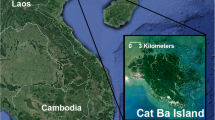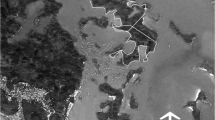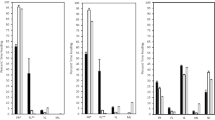Abstract
Understanding how ecological differences between sympatric species lead to coexistence is a fundamental question in primatology. Evidence for intraspecific dietary variation in colobines suggests that findings from a single study site may not be generalizable to other sites. Previous comparative studies of Semnopithecus entellus and Trachypithecus vetulus showed that S. entellus used seasonal plant parts more frequently than did T. vetulus. We examined whether these different food selection strategies can be generalized to explain the species' coexistence at a novel study locality. We collected dietary data for two groups of Semnopithecus entellus and one group of Trachypithecus vetulus between July 2008 and June 2009. We examined the monthly percentage of time devoted to feeding on specific dietary items in relation to their availability, compared the dietary niche breadth of the two species, and quantified the distribution and abundance of resources to examine the potential for intragroup and interspecific competition. Seasonal plant parts accounted for >90 % of the diets of both species and there were no significant differences in monthly dietary breadth or in the monthly proportions of time allocated to feeding on fruits, immature leaves, or mature leaves between the two species. Both species fed on fruits and flowers according to their availability, and most plants preferred by both primate species were relatively rare and clumped in distribution. Such resource distributions are suggested to promote both intragroup and interspecific competition. The food selection strategies of these two primate species are more similar at our study site than at previous study sites, and suggest that these species employ different strategies to facilitate coexistence at different sites.




Similar content being viewed by others
References
Altmann, J. (1974). Observational study of behavior: sampling methods. Behaviour, 49, 227–267.
Aziz, M. A., & Feeroz, M. M. (2009). Utilization of forest flora by Phayre’s leaf-monkey Trachypithecus phayrei (Primates: Cercopithecidae) in semi-evergreen forests of Bangladesh. Journal of Threatened Taxa, 1, 257–262.
Bennett, E. L., & Davies, A. G. (1994). The ecology of Asian Colobines. In D. AG & J. F. Oates (Eds.), Colobine monkeys: Their ecology behaviour and evolution (pp. 129–171). Cambridge: Cambridge University Press.
Brown, J. S., Kotler, B. P., & Mitchell, W. A. (1997). Competition between birds and mammals: a comparison of giving-up densities between crested larks and gerbils. Evolutionary Ecology, 11, 757–771.
Chapman, C. A., & Chapman, L. J. (1999). Implications of small scale variation in ecological conditions for the diet and density of red colobus monkeys. Primates, 40, 215–231.
Chapman, C. A., Wrangham, R. W., & Chapman, L. J. (1995). Ecological constraints on group size: an analysis of spider monkey and chimpanzee subgroups. Behavioral Ecology and Sociobiology, 36, 59–70.
Chapman, C. A., Chapman, L. J., & Gillespie, T. R. (2002). Scale issues in the study of primate foraging: Red colobus of Kibale National Park. American Journal of Physical Anthropology, 117, 349–363.
Chapman, C. A., Chapman, L. J., Rode, K. D., Hauck, E. M., & McDowell, L. R. (2003). Variation in the nutritional value of primate foods: among trees, time periods, and areas. International Journal of Primatology, 24, 317–333.
Charles-Dominique, P. (1974). Ecology and feeding behaviour of five sympatric lorisids in Gabon. In R. D. Martin, G. A. Doyle, & C. A. Walker (Eds.), Prosimian biology (pp. 132–150). London: Duckworth.
Condit, R., Ashton, S., Baker, P., Bunyavejchewin, S., Gunatileke, S., Gunatileke, N., et al. (2000). Spatial patterns in the distribution of tropical tree species. Science, 288, 1414–1418.
Curtin, S. H. (1980). Dusky and banded leaf monkeys. In D. J. Chivers (Ed.), Malayan forest primates: Ten years’ study in tropical rain forest (pp. 105–145). New York: Plenum Press.
Dasilva, G. L. (1994). Diet of Colobus polykomos on Tiwai Island: Selection of food in relation to its seasonal abundance and nutritional quality. International Journal Primatology, 15, 655–680.
Davies, A. G. (1991). Seed-eating by red leaf monkeys (Presbytis rubicunda) in dipterocarp forest of northern Borneo. International Journal of Primatology, 12, 119–144.
Davies, A. G., Oates, J. F., & Dasilva, G. L. (1999). Patterns of frugivory in threeWest African colobine monkeys. International Journal of Primatology, 20, 327–357.
Dela, J. (2007). Seasonal food use strategies of Semnopithecus vetulus nestor, at Panadura and Piliyandala, Sri Lanka. International Journal of Primatology, 28, 607–626.
Dew, J. L. (2005). Foraging, food choice, food processing by sympatric rice-fruit specialists: Lagothrix lagotricha poeppigii and Ateles belzebuth belzebuth. International Journal of Primatology, 26, 1107–1135.
Dittus, W. P. J. (1977). The ecology of a semi-evergreen forest community in Sri Lanka. Biotropica, 9, 268–286.
Fashing, P. J. (2001). Feeding ecology of Guerezas in the Kakamega Forest, Kenya: the importance of Moraceae fruit in their diet. International Journal of Primatology, 22, 579–609.
Fuentes, A. (1996). Feeding and ranging in the Mentawai Island langur (Presbytis potenziani). International Journal of Primatology, 17, 525–548.
Ganzhorn, J. U. (1989). Niche separation of seven lemur species in the eastern rainforest of Madagascar. Oecologia, 79, 279–286.
Ganzhorn, J. U. (2003). Habitat description and phenology. In J. M. Setchell & D. J. Curtis (Eds.), Field and laboratory methods in primatology (pp. 41–56). Cambridge: Cambridge University Press.
Gillespie, T. R., & Chapman, C. A. (2001). Determinants of group size in the red colobus monkey (Procolobus badius): an evaluation of the generality of the ecological-constraints model. Behavioral Ecology and Sociobiology, 50, 329–338.
Grueter, C. C., Li, D., Ren, B., Wei, F., & van Schaik, C. P. (2009). Dietary profile of Rhinopithecus bieti and its socioecological implications. International Journal of Primatology, 30, 601–624.
Guo, S., Li, B., & Watanab, K. (2007). Diet and activity budget of Rhinopithecus roxellana in the Qinling Mountains, China. Primates, 48, 268–276.
Hadi, S., Ziegler, T., Waltert, M., Mühlenberg, M., & Hodges, J. K. (2012). Habitat use and trophic niche overlap of two sympatric colobines, Presbytis potenziani and Simias concolor, on Siberut Island, Indonesia. International Journal of Primatology, 33, 218–232.
Hladik, C. M. (1977). A comparative study of the feeding strategies of two sympatric species of leaf monkeys: Prebytis senex and Presbytis entellus. In T. H. Clutton-Brock (Ed.), Primate ecology: Studies of feeding and ranging behaviour in lemurs, monkeys and apes (pp. 323–353). New York: Academic Press.
Hoang, M. D., Baxter, G. S., & Page, M. J. (2009). Diet of Pygathrix nigripes in southern Vietnam. International Journal of Primatology, 30, 15–28.
Houle, A., Vickery, W. L., & Chapman, C. A. (2006). Testing mechanisms of coexistence among two species of frugivorous primates. Journal of Animal Ecology, 75, 1034–1044.
Huang, C., Wu, H., Zhou, Q., Li, Y., & Cai, X. (2008). Feeding strategy of François’ langur and white-headed langur at Fusui, China. American Journal of Primatology, 70, 320–326.
Isbell, L. A. (1991). Contest and scramble competition: Patterns of female aggression and ranging behavior among primates. Behavioral Ecology, 2, 143–155.
Janson, C. H., & Goldsmith, M. L. (1995). Predicting group size in primates: foraging costs and predation risk. Behavioral Ecology, 6, 326–336.
Kirkpatrick, R. C. (2007). The Asian colobines: Diversity among leaf-eating monkeys. In C. J. Campbell, A. Fuentes, K. C. MacKinnon, M. Panger, & S. K. Bearder (Eds.), Primates in perspective. New York: Oxford University Press.
Koenig, A. (2000). Competitive regimes in forest-dwelling Hanuman langur females (Semnopithecus entellus). Behavioral Ecology and Sociobiology, 48, 93–109.
Koenig, A., & Borries, C. (2001). Socioecology of hanuman langurs: the story of their success. Evolutionary Anthropology, 10, 122–137.
Koenig, A., Beise, J., Chalise, M. K., & Ganzhorn, J. U. (1998). When females should contest for food-testing hypotheses resource density, distribution, size, and quality with Hanuman langurs (Presbytis entellus). Behavioral Ecology and Sociobiology, 42, 225–237.
Kool, K. M. (1989). Behavioral ecology of the silver leaf monkey, Trachypithecus auratus sondiacus, in the Pangandaran Nature Reserve, West Java, Indonesia. Ph.D. thesis, University of New South Wales, Sydney.
Krebs, C. J. (1999). Ecological methodology. New York: Addison-Wesley Longman.
Li, Z., & Rogers, M. E. (2006). Food items consumed by white-headed langurs in Fusui, China. International Journal of Primatology, 27, 1551–1567.
Maisels, F., Gautier-Hion, A., & Gautier, J. P. (1994). Diets of two sympatric colobines in Zaire: more evidence on seed-eating in forests on poor soils. International Journal of Primatology, 15, 681–701.
McKey, D. B., Gartlan, J. S., Waterman, P. G., & Choo, G. M. (1981). Food selection by black colobus monkeys (Colobus satanas) in relation to food chemistry. Biological Journal of the Linnean Society, 16, 115–146.
Newton, P. (1992). Feeding and ranging patterns of forest hanuman langurs (Presbytis entellus). International Journal of Primatology, 13, 245–285.
Oates, J. F. (1988). The diet of olive colobus monkey, Procolobus verus, in Sierra Leone. International Journal of Primatology, 9, 457–478.
Oates, J. F., Waterman, P. G., & Choo, G. M. (1980). Food selection by the south Indian leaf-monkey, Presbytis johnii, in relation to leaf chemistry. Oecologia, 45, 45–56.
Phillips, W. W. A. (1935). Manual of the mammals of Ceylon. London: Dulan.
Ripley, S. (1965). The ecology and social behavior of the Ceylon gray langur, Presbytis entellus thersites. Ph.D. thesis, University of California, Berkeley.
Ripley, S. (1967). Intertroop encunters among Ceylon gray langurs (Presbytis entellus). In S. A. Altmann (Ed.), Social communication among primates (pp. 237–253). Chicago: University of Chicago Press.
Ripley, S. (1970). Leaves and leaf-monkeys: The social organization of foraging in grey langurs. In J. R. Napier & P. H. Napier (Eds.), Old World monkeys: Evolution, systematics and behaviour (pp. 481–509). New York: Academic Press.
Rudran, R. (1973a). Adult male replacement in one-male troops of purple-faced langurs (Presbytis senex senex) and its effect on population structure. Folia Primatologica, 19, 166–192.
Rudran, R. (1973b). The reproductive cycles of two subspecies of purple-faced langurs (Presbytis senex) with relation to environmental factors. Folia Primatologica, 19, 41–60.
Saj, T. L., & Sicotte, P. (2007a). Predicting the competitive regime of female Colobus vellerosus from the distribution of food resources. International Journal of Primatology, 28, 315–336.
Saj, T. L., & Sicotte, P. (2007b). Scramble competition among the ursine colobus (Colobus vellerosus) at Boabeng-Fiema, Ghana. International Journal of Primatology, 28, 337–355.
Sayers, K., & Norconk, M. A. (2008). Himalayan Semnopithecus entellus at Langtang National Park, Nepal: Diet, activity patterns, and resources. International Journal of Primatology, 28, 509–530.
Schoener, T. W. (1983). Field experiments on interspecific competition. The American Naturalist, 122, 240–285.
Sokal, R. R., & Rohlf, F. J. (1995). Biometry. New York: W. H. Freeman.
Solanki, G. S., Kumar, A., & Sharma, B. K. (2008). Feeding ecology of Trachypithecus pileatus in India. International Journal of Primatology, 29, 173–182.
Stanford, C. B. (1991). The capped langur in Bangladesh: Behavioral ecology and reproductive tactics. Contributions to Primatology, 26, 1–179.
Steenbeek, R., & van Schaik, C. P. (2001). Competition and group size in Thomas’s langurs (Presbytis thomasi): the folivore paradox revisited. Behavioral Ecology and Sociobiology, 49, 100–110.
Sterck, E. H. M., Watts, D. P., & van Schaik, C. P. (1997). The evolution of female social relationships in nonhuman primates. Behavioral Ecology and Sociobiology, 41, 291–309.
Struhsaker, T. T. (1975). The red colobus monkey. Chicago: University of Chicago Press.
Struhsaker, T. T. (1978). Food habits of five monkey species in the Kibale Forest, Uganda. In D. J. Chivers & J. Herbert (Eds.), Recent advances in primatology, vol. 1 (pp. 225–248). New York: Academic Press.
van Schaik, C. P. (1989). The ecology of social relationships amongst female primates. In V. Standen & R. A. Foley (Eds.), Comparative socioecology. The behavioural ecology of humans and other mammals (pp. 195–218). Oxford: Blackwell.
Vandercone, R. (2011). Dietary shifts, niche relationships and interspecific competition in the sympatric grey langur (Semnopithecus entellus) and the purple-faced langur (Trachypithecus vetulus) in Sri Lanka. Ph.D. thesis, Washington University, St. Louis.
Workman, C. (2010). Diet of the Delacour’s langur (Trachypithecus delacouri) in Van Long Nature Reserve, Vietnam. American Journal of Primatology, 72, 317–324.
Wrangham, R. W. (1980). An ecological model of female-bonded primate groups. Behaviour, 75, 262–300.
Xiang, Z., Huo, S., Xiao, W., Quan, R., & Grueter, C. C. (2007). Diet and feeding behavior of Rhinopithecus bieti at Xiaochangdu, Tibet: adaptations to a marginal environment. American Journal of Primatology, 69, 1141–1158.
Yeager, C. P. (1989). Feeding ecology of the proboscis monkey (Nasalis larvatus). International Journal of Primatology, 10, 497–530.
Zhou, Q., Wei, F., Li, M., Huang, C., & Luo, B. (2006). Diet and food choice of Trachypithecus francoisi in the Nonggang Nature Reserve, China. International Journal of Primatology, 27, 1441–1460.
Ziv, Y., & Kotler, B. P. (2003). Giving-up densities of foraging gerbils: the effects of interspecific competition on patch use. Evolutionary Ecology, 17, 333–347.
Acknowledgments
This research was supported by grants from Primate Conservation Inc., Idea Wild, Margot Marsh Biodiversity Fund, Lambda Alpha National Collegiate Honors Society for Anthropology, and a Conservation Food and Health Foundation grant awarded to Rajnish Vandercone of Washington University. We also thank the Department of Wildlife Conservation for Sri Lanka for providing us with the necessary permission to conduct field work in Sri Lanka. The protocols described in this article were reviewed and approved by the Animal Studies Committee of Washington University and the Department of Wildlife Conservation of Sri Lanka. We are extremely grateful to Drs. Crickette Sanz and Jennifer Rehg for reading and providing valuable feedback of preliminary versions of the manuscript. We also thank Drs. Joanna Setchell and Oliver Schülke and two other anonymous referees for their valuable comments.
Author information
Authors and Affiliations
Corresponding author
Rights and permissions
About this article
Cite this article
Vandercone, R.P., Dinadh, C., Wijethunga, G. et al. Dietary Diversity and Food Selection in Hanuman Langurs (Semnopithecus entellus) and Purple-Faced Langurs (Trachypithecus vetulus) in the Kaludiyapokuna Forest Reserve in the Dry Zone of Sri Lanka. Int J Primatol 33, 1382–1405 (2012). https://doi.org/10.1007/s10764-012-9629-9
Received:
Accepted:
Published:
Issue Date:
DOI: https://doi.org/10.1007/s10764-012-9629-9




